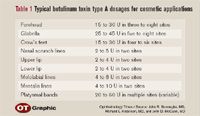Article
Facial anatomy key to optimal use of botulinum toxin
Author(s):
Botulinum toxin type A effect is usually seen 2 to 3 days following injection, with maximal effect at approximately 2 weeks. Touch-ups are not recommended until 2 weeks have passed.

The pioneering work on ophthalmic use of botulinum toxin type A, done by Scott et al. more than 25 years ago, was for strabismus. In 1989, botulinum toxin type A was approved for blepharospasm, hemifacial spasm, torticollis, and strabismus. Since then it has been approved for cosmetic treatment of glabellar furrows and primary axillary hyperhydrosis.

Botulinum toxin type A is extremely safe, with an LD50 of 3,500 units in humans. Despite its safety, non-life-threatening complications can be frequent and frustrating. Proper understanding of facial anatomy is paramount to correct understanding of the indications and proper administration. Botulinum toxin type A will not address skin pigmentation/quality, excess skin, contour deformities, volume loss/deformities, or tissue descent.

Procedure
A half-inch 32-gauge needle (distributed by Air-Tite Products, 800/231-7762) minimizes injection discomfort. We inject the lips and eyelid areas first because these are the most uncomfortable injection sites. It is desirable to switch out the needle if it becomes dull, to improve patient comfort with multiple injection sites. In the periorbital areas we inject in a manner oblique to the skin to lessen the risk of deep injection or even globe injury should a patient suddenly move. Pinching upward or gently rubbing the adjacent skin during injection minimizes patient discomfort by distracting the patient during the injection and "confusing" the sensory sensation of the injection.
We recommend pre-marking the injection areas and utilize bright lighting and magnification to avoid injury to eyelid vessels. Injections should not be given directly into the marked areas but under them to avoid marker pigment tattooing.
We seldom use topical anesthetics, and a recent study demonstrated a lack of pain reduction but a reduced duration of effect in patients treated with topical anesthetic prior to injection. We inject into the subcutaneous tissue planes to avoid the underlying muscle and neurovascular structures. This reduces patient discomfort, bruising, and deep dissemination. When injecting into the lower orbicularis areas, placing the skin on stretch helps with placement in the subcutaneous plane.
Botulinum toxin type A must be avoided in the central upper eyelid to prevent ptosis and over the inferior oblique in the lower eyelid to avoid diplopia.




